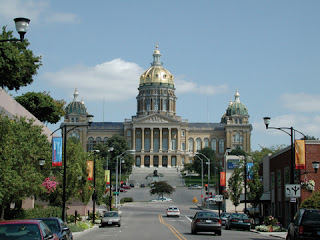 |
| Des Moines |
Des Moines is a small, pretty, unexciting city, the capital of Iowa, a small, pretty, unexciting state. Des Moines is very like a small Omaha, with their shared propensity for the insurance and food industries, and is the headquarters of the Principal Financial Group, the National Pork Producers Council, Wellmark Blue Cross Blue Shield, and the Kum and Go chain.
 It is not known for arts and culture, but if you're on Interstate 80 en route to Chicago, Minneapolis, Kansas City, or St. Louis, you should stretch your legs for a couple of hours at The John and Mary Pappajohn Sculpture Park, a 4.4-acre park that opened in Des Moines in 2009. It is worth much more than a drive-by: you have to get down and dirty, close to the sculptures to get the effects and the atmosphere. (Above: "Spider," a bronze sculpture by Louise Bourgeois, an American artist who is drawn to the spider as a symbol of mothers, not of predators.)
It is not known for arts and culture, but if you're on Interstate 80 en route to Chicago, Minneapolis, Kansas City, or St. Louis, you should stretch your legs for a couple of hours at The John and Mary Pappajohn Sculpture Park, a 4.4-acre park that opened in Des Moines in 2009. It is worth much more than a drive-by: you have to get down and dirty, close to the sculptures to get the effects and the atmosphere. (Above: "Spider," a bronze sculpture by Louise Bourgeois, an American artist who is drawn to the spider as a symbol of mothers, not of predators.)I took these straightforward snapshots. I have relied for information on an excellent visitor brochure, a kind of Self-Guided Tour.
 |
| "Post Balzac," cast bronze and stone, by Judith Shea, American artist, 1990 |
Above is one of my favorite sculptures, "Post Balzac," by Judith Shea, based on Rodin's 1898 Monument to Balzac. Shea's coat stands empty, no Balzac in it, while Rodin's sculpture shows Balzac wrapped in his coat.
 |
| Rodin's sculpture |
Shea said about "Post Balzac": "I wanted to address how, at the end of the last (19th) century, there was both romance and optimism for the next century. I wanted to ask, 'Where are we a century later?' This century's technical innovations have brought horrors, with the level of destruction we are able to do. The coat is hollow--a metaphor of the condition of the spirit, for emptiness." The numeral XX is inscribed on the base, referring to the 20th century. Do we have a contemporary Balzac? A humaine comedy? Who writes that many books? No one comes to mind.
 I love this sculpture, being a fan of Balzac. And so here is my photo--I've taken off my coat as a gesture--beside the statue. The tourist who took this didn't think it was very good, but it's nice to have a memento; I do look unglamorous but at least real. I suspect this is how I look. Yes, I WOULD wear an old sweatshirt on the DAY I FINALLY GET MY PICTURE TAKEN.
I love this sculpture, being a fan of Balzac. And so here is my photo--I've taken off my coat as a gesture--beside the statue. The tourist who took this didn't think it was very good, but it's nice to have a memento; I do look unglamorous but at least real. I suspect this is how I look. Yes, I WOULD wear an old sweatshirt on the DAY I FINALLY GET MY PICTURE TAKEN. Here is my "Post-Me" sculpture (this is a very silly joke): empty coat, with bike helmet on top and 21st-century can't-be-without Starbucks coffee cup on side:
I didn't go around the whole park. I spent two hours. I loved the beautiful cast aluminum and white enamel sculpture of the tree (below), titled "air gets into everything even nothing," (2006) by Ugo Rondinone, a Swiss artist.
Rondinone is interested in "natural and artificial environments." This is a replica of a 2,000-year-old olive tree, but because it is aluminum, she sees this image as being without history. (See the brochure for more.)
My only criticism: other collectors should also donate art to the park. Different tastes, you know?
By the way, I recently read that John Pappajohn, the venture capitalist, art collector, and philanthropist who, with his wife, Mary, donated the art for this park, intervened recently when the University of Iowa considered selling a painting by Jackson Pollock. According to the Des Moines Register, he said,
"If you mention the University of Iowa Art Museum to anyone in the art world anywhere in the world, they'll say the Pollock piece. It's an icon, the pristine piece in the collection. Selling this pristine piece would discredit the entire university and the university museum. It would be a terrible reflection on the state with far-reaching effects. I can't emphasize this more. Do you realize the museum will probably lose its accreditation?"
And the university decided to keep the painting.


No comments:
Post a Comment